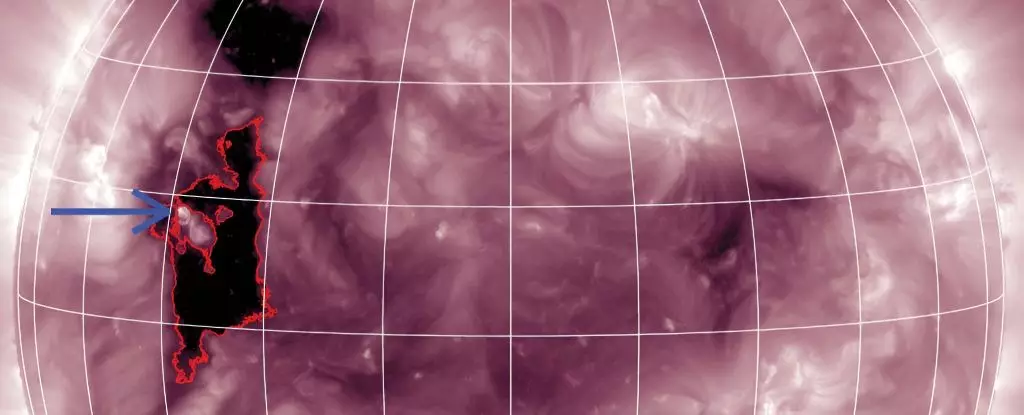In a groundbreaking discovery made in late October 2023, astronomical observations revealed an extraordinary phenomenon: a massive influx of helium-3, a rare isotope of helium, emanating from the Sun’s atmosphere. This event marked the largest recorded release of helium-3 from our solar star, entirely reshaping our understanding of solar dynamics. The implications of such a finding stretch far beyond mere academic interest, engaging with fundamental questions about the nature of the Sun and its material emissions.
As astrophysicists like Radoslav Bučík of the Southwest Research Institute in the United States explained, helium-3 occurs at an incredibly low ratio compared to its more abundant counterpart, helium-4. With only one helium-3 ion present for every 2,500 helium-4 ions, the sudden spike in helium-3 emissions signifies a unique solar mechanism that deserves further inquiry. Why is it that solar jets can preferentially accelerate this lighter isotope? This question hints at underlying processes that govern particle dynamics in the solar atmosphere, promising tantalizing insights into the mechanics of stellar phenomena.
The Enigmatic Coronal Hole
The epicenter of this helium-3 surge was traced back to a coronal hole—a temporary feature in the Sun’s outer atmosphere characterized by its weak magnetic fields. Through advanced imaging techniques available to space agencies like ESA and NASA, scientists identified this hole as a crucial player in the observed particle event. Unlike the denser regions of the solar corona, coronal holes are cooler and less dense, allowing for a more efficient escape of solar wind.
Interestingly, the magnetism of the area did not conform to expectations associated with active solar regions; instead, the weak magnetic fields present were akin to those found in calmer solar territories. This unexpected finding bolsters previous theories positing that weakly magnetized regions could enhance helium-3 enrichment by minimizing turbulence, thereby making the conditions ripe for accelerated emissions of this rare isotope.
Elevated Helium-3 Concentrations
During the solar events of October 24 and 25, the Solar Orbiter space observatory made astounding measurements of helium-3 concentrations that were 180,000 times greater than typical solar atmospheric levels. This finding raises pivotal questions about the mechanisms that can lead to such unprecedented enrichment. What conditions allowed for this remarkable accumulation? Are we observing an occasional anomaly, or does this jet signal the presence of a consistent but previously undetected mechanism influencing solar composition?
The solar jet responsible for these emissions was not just a façade of helium-3; intriguingly, it also carried an atypical array of other lighter elements, including carbon, nitrogen, silicon, and sulfur. The remarkable absence of heavier elements such as iron in this particle event suggests an entirely new class of solar behavior. The rarity of similar chemical profiles—only 19 documented events between 1999 and 2023—implies that the mechanisms driving these emissions could either be exceptionally rare or have gone unnoticed due to weak activity levels.
Solar Orbiter: A New Perspective
Positioned halfway between Earth and the Sun, the Solar Orbiter provides a profound vantage point for studying the dynamic processes at play in our closest star. This spacecraft has proven invaluable in its ability to capture data on solar phenomena that tend to elude ground-based observatories. As we unlock the secrets of solar jets and their remarkable behavior, we inch closer to a sophisticated understanding of the complex interplay between magnetic forces, particle acceleration, and elemental distribution.
The scientific community stands on the edge of a new frontier in solar research. Each finding within the solar atmosphere impacts our broader understanding of the universe, from stellar evolution to potential implications for future space exploration. By investigating these mysterious solar jets that deliver such rare enrichments, we not only explore the dynamics of our Sun but also carry forward a narrative that ties our existence to the celestial bodies that surround us.
In essence, the October 2023 solar event emphasizes the importance of continued exploration and research in astrophysics. With every new discovery, we are challenged to reconsider our place in the cosmos, continually unraveling the interwoven story of elements, forces, and the stars. The universe is richer, more dynamic, and infinitely more intriguing than previously imagined.

